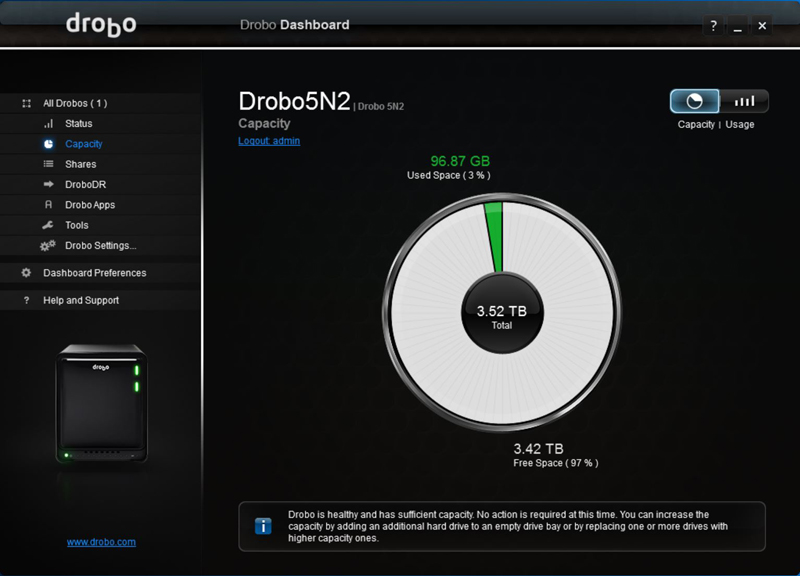

- #Drobo dashboard display movie
- #Drobo dashboard display install
- #Drobo dashboard display full
- #Drobo dashboard display Pc
However, the one technical flaw that I have encountered is the fact that darn thing is a noisy device, the fan of the Drobo really makes a lot of noise. It does what it should do and it really is a no-brainer to install/work with.
#Drobo dashboard display Pc
However, if your Drobo is connected to a fixed computer ( a tower of some sorts) via USB ( which it was in my case) it will automatically boot up and shut down whenever your PC starts up/shuts down Quite handy indeed! This sounds great! Why do you have mixed feelings about this device?įrom a technical point of view the Drobo indeed is a great device. What I’m trying to say is: think twice before buying one if you have a laptop which you move around all the time … it’s quite tedious to standy it all the time whenever you move your laptop / put your laptop to sleep ( also see the “Sleeping Tech Support” issue a bit further in this post) you just pull out the USB plug) you will indefinitely lose data. If you do want to move it to an other computer, you have to put the Drobo unit into standby via the Drobo Dashboard software. What you also should know is that the Drobo is not your typical external hard drive ( which you plug in, push data on, pull out, plug into another PC and get data off) The Drobo is a storage unit which will stay in place, connected to the one computer you hook it too (or onto the DroboShare) If you do however have more real storage capacity than virtual capacity, the Drobo will assign an extra drive ( a FAQ on this topic can be read here) Plug and Play, aye? I advise one to switch to Vista/OSX as 2TB will eventually hit you on the head (if you format it as 16TB I think one has quite a few years to go) as it’s not possible to increase this virtual drive size without formatting your Drobo. It should also be noted that XP users won’t be able to format the Drobo to being 16TB as that OS is limited to 2TB.
#Drobo dashboard display movie
Of course, as the movie states, you can still use your Drobo during this process. I did the test and yanked out one of the three hard drives my Drobo has and it took about 6 hours to rebuild. However, what they don’t tell you in the movie ( but you should know if you’ve worked with RAID arrays before) is that reorganizing takes quite some time. The great part of the whole process above is that your Drobo will always appear as being 16TB in your OS. What was I talking about? Right: the fake formatting. If you do tuck in an extra HD, it will reorganize itself to give you the best protection it can give you.
#Drobo dashboard display full
If you don’t do that the Drobo will drop the data protection and use the full 2TB it has. If then my Drobo would go nearly full, it will advise you to put in an extra HD ( via the yellow/orange indication – as seen on both on the unit itself, as in the dashboard). The green bars indicate that both HDs work fine and that there’s enough capacity left. You can see this in action the screenshot below: my Drobo is set up with 1TB real capacity ( 2x1TB, mirrored automatically for data protection) of which only 100MB data is used. The smart Drobo kicks in when you’ve reached nearly the maximum of the real storage capacity ( somewhere around 0.8TB in the example): a light will go on telling you put in more disks. Your OS will detect 16TB and let you fill her up to that. What could’ve been explained better in the documentation is that the formatting actually is a fake formatting: you format your Drobo to being 16TB ( for example), even if you only tuck in 1TB of real capacity.
#Drobo dashboard display install
Setting it up ain’t that hard: install the Drobo Dashboard, plug in the Drobo ( don’t recall if that was instructed to be with or without drives in the Drobo), format it and go nuts 🙂


 0 kommentar(er)
0 kommentar(er)
